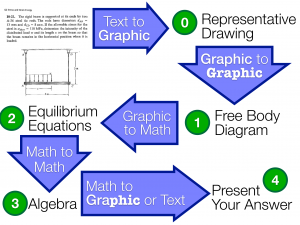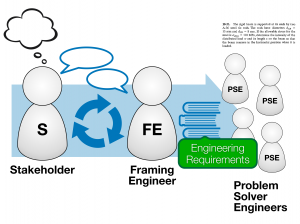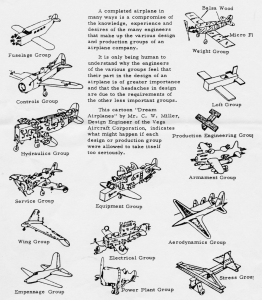Engineering Design as Translation
Published on September 23, 2018
Consider engineering as an act of translation, generating and applying different representations (words, models, equations, diagrams, etc.) to the practices of design and problem solving. The engineer perpetually moves between the world of theory and reality, and each step in between requires translation. As they design, they must also negotiate the different language(s) of their stakeholders to develop nuanced and complete requirements. They must also move between the different languages of different disciplines, as an electrical engineer will envision things quite differently from a mechanical engineer.
This was Professor Jason Foster’s message in our second plenary talk at ProComm 2018. As we seek to understand certain phenomena, design problems, and the world around us in general, we often have to move between different representations (Figure 1) to find an answer or a solution. A textual problem may require a drawing, which may then necessitate a simplified drawing, that will allow for an initial and subsequent mathematical representations, which we can then turn into a textual or verbal answer. As we move between each of these steps, we are effectively translating between different languages, and our ability to find a solution requires us to move between these different domains.

Figure 1: Moving between representations in engineering
That’s why, he argued, we should – in order to understand a concept or a problem better – simply try to explain it to another person, to represent it in terms someone else can grasp, a strategy known as rubber ducking in the software world. Finding a different language can be pivotal to our own understanding, which is why he pushes his students to represent problems in multiple ways, exposing hidden assumptions and meanings as we move between discursive realms.
Translation is also pivotal to the engineering design process, as engineers must find a way to move from the voice of the stakeholders into engineering requirements (Figure 2). The entire act of engineering design relies on this, and the best engineers will immerse themselves in their stakeholders’ experience and develop a rich, nuanced understanding which they translate into “engineer-speak.” How we understand a problem depends on this act of translation. When people complain about the speed of the elevator, do we hear “Change the elevator” or “Change the perception?” When we say that too many motorcyclists are dying in accidents, do we hear “Mitigate the effects of accidents” or “Eliminate accidents?” The power of this initial framing shows that how we hear, understand, and translate has incredible influence over how and what we design.

Figure 2: The Engineering Designer as Translator
Not only does translation happens between engineers and the world, it occurs within the engineering as well, as each discipline has its own unique language and perspective. In the above elevator problem, for example, a computer engineer might see a software problem, whereas a mechanical engineer might see mechanical issues, and an industrial engineer might see a usability problem. Figure 3, Dream Airplanes, by C.W. Miller shows us how different engineering groups might look at a plane; another famous cartoon documenting the problem of translation in design, How the Customer Explained It, has itself become so ubiquitous it’s now a meme.

Figure 3: Dream Airplanes
What translation’s primacy in engineering theory and practice means is that communication is paramount. As we engineer, we rely on communication acts to understand (and make tractable) problems and enable solutions. And the more aware we are of the power and implications of our communicative acts, the better we are as engineers.
 Jason Foster is an Associate Professor of Engineering Design, Teaching Stream within the Division of Engineering Science at the University of Toronto. In this role he has co-developed and co-taught eight engineering design courses, spanning the first through fourth years of study and class sizes from 10 to 300 students, many of which integrate engineering communication into the design curriculum. A systems design engineer by training, and an engineering educator by choice, he has researched the theory, practice, and teaching of engineering design throughout his career. He has won numerous teaching awards, including the Joan E. Foley Quality of Student Experience Award.
Jason Foster is an Associate Professor of Engineering Design, Teaching Stream within the Division of Engineering Science at the University of Toronto. In this role he has co-developed and co-taught eight engineering design courses, spanning the first through fourth years of study and class sizes from 10 to 300 students, many of which integrate engineering communication into the design curriculum. A systems design engineer by training, and an engineering educator by choice, he has researched the theory, practice, and teaching of engineering design throughout his career. He has won numerous teaching awards, including the Joan E. Foley Quality of Student Experience Award.
Summary by Alan Chong.

